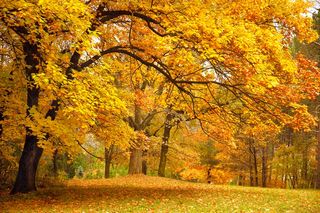Fall's Back! Equinox Heralds Colorful Leaves and Bad Weather

Today marks the official close to summer and the beginning of the new fall season. This seasonal phenomenon is known as the autumnal, or fall, equinox. It is one of only two times each year when the Earth's axis is not tilted toward or away from the sun, which results in a day that will have nearly equal amounts of daylight and darkness at all latitudes.
The equinox occurred this morning at 4:22 a.m. EDT (8:22 a.m. GMT). Typically, the equinox falls on Sept. 22, but the Gregorian calendar, which most of the world uses today, is imperfect, and its days and months don't precisely represent the position of the Earth in its orbit around the sun. This means that sometimes the Earth isn't in the same spot every year on a given date, which is why this year's equinox came later than usual.
The nearly equal hours of day and night across all latitudes of the planet on the equinox occurs when the geometric center of the sun's disk is crossing the equator, according to the U.S. Naval Observatory. The exact hours of daylight in a specific city do vary depending on that spot on Earth's distance from the sun. [Turning Leaves: The Rich Colors of Fall Foliage]
For people who live within a couple of degrees of the equator, the period from sunrise to sunset is always several minutes longer than the night. At higher latitudes in the Northern Hemisphere, the date of equal daylight and darkness comes at the end of a period with longer daylight hours and this marks the shift to less light hours as this hemisphere transitions to cooler weather. And for the Southern Hemisphere, everything is reversed because this half of the planet has different seasonal patterns, which means that this part of the world is transitioning into a warmer season with more light hours in the day
However, the fall season brings more than just shorter daylight hours, changing leaf colors and an abundance of seasonal treats. The National Oceanic and Atmospheric Administration's National Weather Service warns that the new season also brings the potential for hazardous weather. Starting in early September, meteorologists are on the lookout for the strong storm surges, wildfires, early winter weather and drought that accompany fall weather changes.
At this time of year, the two weather hazards that affect most regions of the United States are wind and flooding. "Wind damage can be very damaging to property," Katie Collins Garrett, a meteorologist at NOAA's National Weather Service, told Live Science. "It's not flashy like a tornado, but it knocks down power lines [and] trees, and tears off shingles from roofs." She mentioned that across the Great Plains, wind has even been known to blow over large trucks driving down the highway.
Flooding can be a bit more deadly, Garret said. "It's actually one of the top weather killers. It's the second behind heat," she added. While destructive tornadoes and hurricanes do have higher fatalities, flooding consistently kills dozens of people each year, according to the National Weather Service.
Sign up for the Live Science daily newsletter now
Get the world’s most fascinating discoveries delivered straight to your inbox.
While these hazards may not be everyday occurrences, Garrett said it's better to be educated about the hazards that can occur in your own community. "It's important to not let preparation for hazards get put on the back burner, since they can happen throughout the season," she said.
So this fall season, keep an eye on the weather while you sip your pumpkin spice lattes, and don't get caught unawares.
Follow Elizabeth Newbern @liznewbern. Follow Live Science @livescience, Facebook & Google+. Original article on Live Science.
Most Popular

